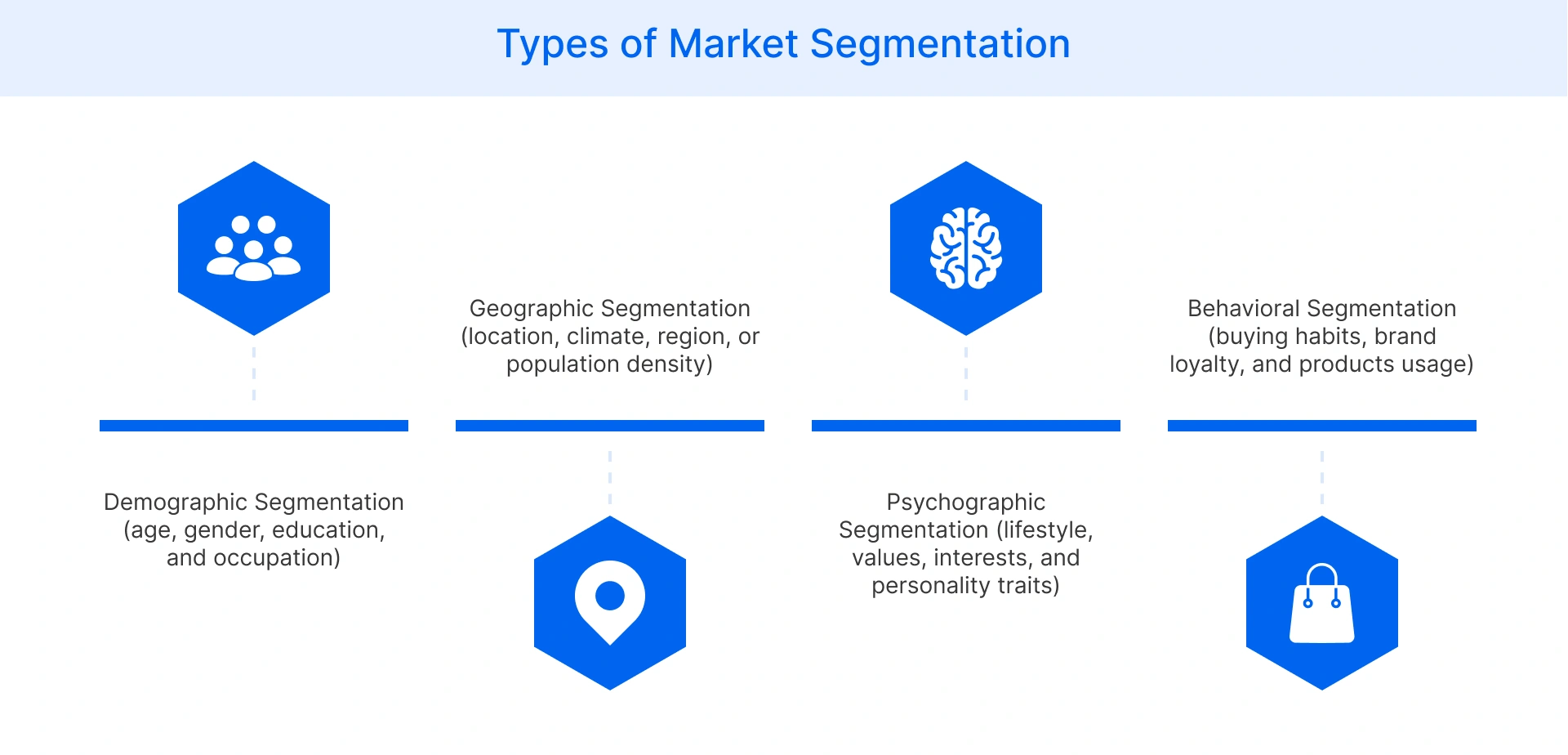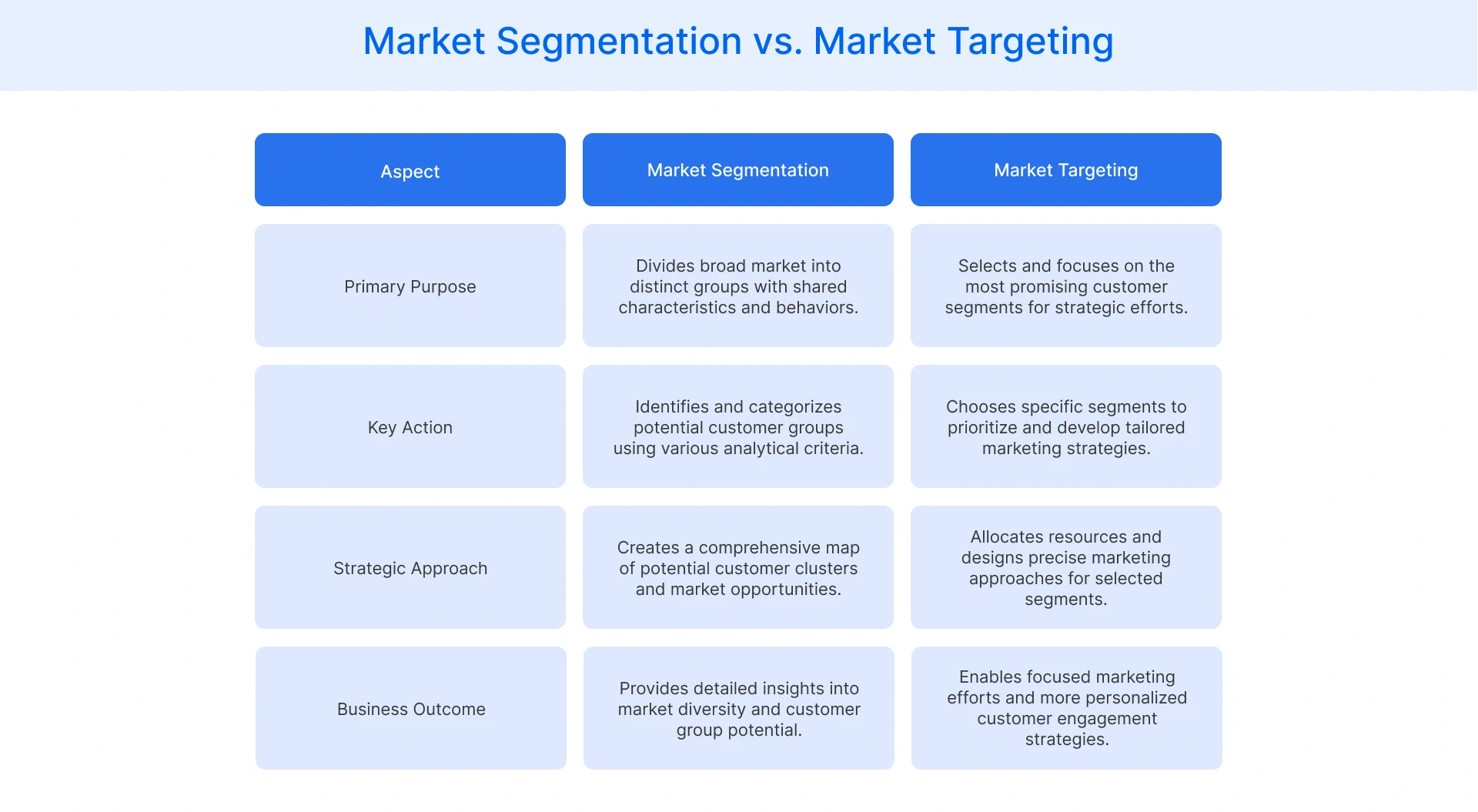Table of Contents
- What is Market Segmentation?
- Types of Market Segmentation
- Market Segmentation vs. Market Targeting
- Steps to Implement Market Segmentation
- Conclusion
What is Market Segmentation?
Market segmentation is a strategic approach that categorizes a diverse consumer base into smaller and well-defined groups based on common characteristics. This classification enables businesses to create personalized marketing campaigns, develop relevant products, and enhance customer engagement by addressing specific needs.
Retailers and businesses use market segmentation to refine their messaging, optimize resource allocation, and improve sales effectiveness. By identifying patterns in customer preferences, companies can deliver targeted promotions and enhance the overall shopping experience.
Effective market segmentation ensures that marketing efforts are directed toward the most relevant audience segments, increasing conversion rates and customer retention. It also allows businesses to differentiate themselves in a competitive market by tailoring their value propositions to distinct consumer groups.
Types of Market Segmentation
Market segmentation helps businesses target customer groups more effectively. These approaches allow retailers to refine marketing strategies, improve customer engagement, and align products with consumer needs.
Demographic Segmentation
Demographic segmentation classifies consumers based on age, gender, income, education, and occupation. Retailers use this method to develop tailored marketing campaigns and product offerings that align with distinct customer profiles. For example, luxury brands often target high-income groups, while budget-friendly retailers cater to price-sensitive consumers.
Understanding demographic patterns helps businesses optimize pricing strategies, refine product positioning, and enhance customer outreach efforts. By leveraging demographic insights, retailers can create personalized promotions, ensuring that their messaging aligns with the preferences of specific consumer segments.
Geographic Segmentation
Geographic segmentation divides markets based on physical location and environmental characteristics that impact consumer behavior. This strategy recognizes that customer preferences vary significantly across different regions, climates, and population densities. Retailers can use geographic insights to adapt new products, marketing messages, and store strategies.
Key geographic segmentation factors include:
- Regional preferences and cultural nuances
- Urban, suburban, and rural market differences
- Climate-specific product requirements
- Population density and its impact on shopping behaviors

Psychographic Segmentation
Psychographic segmentation delves deeper than demographic data, exploring the psychological aspects that drive consumer choices. This approach segments markets based on lifestyle, values, interests, and personality traits. By understanding their customers' underlying motivations and emotional drivers, retailers can create more meaningful connections.
Critical psychographic segmentation elements are:
- Lifestyle and personal values
- Interests and hobbies
- Personality characteristics
- Social status and aspirations
- Personal beliefs and motivations
Behavioral Segmentation
Behavioral segmentation categorizes target audience based on purchasing habits, brand loyalty, product usage, and engagement patterns. Retailers use this method to identify frequent buyers, seasonal shoppers, and first-time customers, enabling them to tailor promotions accordingly.
For example, loyal customers may receive exclusive discounts, while new shoppers might be encouraged through introductory offers. By tracking behavioral trends, businesses can refine their marketing efforts, increase conversion rates, and build long-term relationships with customers through personalized engagement strategies.
Market Segmentation vs. Market Targeting
Market segmentation and market targeting are closely related but serve distinct purposes in developing effective retail strategies.
- Market segmentation involves categorizing consumers into groups based on shared characteristics, such as demographics, behaviors, or location. This process helps retailers understand their audience better and create tailored marketing approaches.
- Market targeting, on the other hand, is the next step, where businesses evaluate different market segments and decide which groups to prioritize. Instead of addressing all segments equally, retailers focus on the most profitable or relevant ones.
By combining segmentation and targeting, businesses maximize marketing efficiency, improve customer engagement, and optimize product positioning.

Steps to Implement Market Segmentation
Here are the steps to ensure accurate segmentation for better customer engagement and improved business performance.
Identify Market Segmentation Criteria
Selecting the right segmentation criteria is crucial for meaningful market division. Consider factors such as demographics, location, behavior, and psychographics based on business goals and industry trends. For example, luxury brands may prioritize income levels, while local retailers might focus on geographic proximity. Defining clear criteria ensures segmentation aligns with market needs and business objectives.
Collect and Analyze Data
Accurate data collection is essential for effective segmentation. Use customer surveys, purchase history, website analytics, and social media insights to identify patterns in consumer preferences. Data-driven insights help retailers understand buying habits, brand interactions, and emerging trends, allowing them to create personalized marketing strategies that resonate with target customer groups.
Segment the Market
Once data is collected, divide customers into well-defined segments based on shared attributes. Grouping consumers by age, interests, purchasing behavior, or regional demand allows businesses to tailor offerings. For instance, seasonal promotions may be targeted at customers who shop during specific times, maximizing campaign effectiveness and engagement.
Evaluate and Refine Segments
Regularly reviewing and updating segments ensures relevance and accuracy. Consumer preferences change over time, requiring businesses to adjust strategies. Track sales performance, customer feedback, and market trends to refine segmentation models. Adapting to evolving consumer needs helps retailers maintain engagement, improve conversion rates, and sustain long-term growth.
Conclusion
Market segmentation is a transformative strategy that empowers retailers to understand, target, and engage their customers with unprecedented precision. By breaking down broad markets into meaningful groups, businesses can create personalized and effective marketing approaches that drive growth and customer satisfaction.
At Flipkart Commerce Cloud, we have developed cutting-edge solutions that take market segmentation to the next level. Our Marketplace Technology Stack offers a comprehensive suite of over 40 plug-and-play components that enable retailers to launch and scale their online presence with advanced capabilities built on 15 years of retail expertise.
Our Retail Pricing Manager is a prime example of how advanced market segmentation can drive business success. This cloud-based SaaS solution helps retailers understand competitive pricing strategies, optimize pricing to maximize margins and volumes, and uses machine learning models to learn price elasticity of demand from historical sales data. By leveraging sophisticated machine learning algorithms, we enable retailers to segment their markets effectively and make data-driven decisions.
FAQ
Market segmentation enables businesses to set competitive prices by understanding different consumer groups’ purchasing power, preferences, and willingness to pay. Retailers can implement value-based pricing, premium pricing, or discount strategies based on segment characteristics, ensuring products remain attractive and profitable across diverse market segments.
Market segmentation categorizes a broad audience into groups based on shared characteristics, while customer segmentation focuses on existing customers' behaviors and preferences. Market segmentation guides brand positioning and strategy, whereas customer segmentation helps businesses personalize interactions and enhance customer experience through tailored marketing efforts.
Yes, businesses can target multiple market segments by tailoring messaging, pricing, and product offerings to different consumer groups. A multi-segment approach allows companies to expand their reach, diversify revenue streams, and improve engagement. However, balancing resources and ensuring each segment receives personalized attention is crucial for sustained success.
A company should review its market segmentation strategy at least once a year or whenever significant market shifts occur. Changing consumer preferences and technological advancements impact segmentation effectiveness. Regular updates help businesses refine targeting and improve marketing performance to stay competitive in dynamic retail environments.

